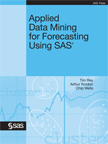In the course of my job, I get to have a lot of conversations with authors about their books. One of the aspects of those conversations I enjoy most is learning about their areas of expertise and knowledge—that could be certain SAS software or programming techniques, particular fields of analytics, or new ways of thinking about statistics. It’s part of finding out what makes our authors experts and why their books will be of interest to users.
 In working with Tim Rey, Arthur Kordon, and Chip Wells, I found out that with the explosion of available time series data and data services, forecasting problems now necessitate the use of data mining approaches for variable reduction and variable selection. So I wondered, what else do these experts want to tell us about data mining for forecasting? Here’s what they had to say:
In working with Tim Rey, Arthur Kordon, and Chip Wells, I found out that with the explosion of available time series data and data services, forecasting problems now necessitate the use of data mining approaches for variable reduction and variable selection. So I wondered, what else do these experts want to tell us about data mining for forecasting? Here’s what they had to say:
- ARMA models are transfer functions with a white noise input or impulse generator. Dynamic regression models are transfer functions with other (e.g., interval or binary valued) kinds of inputs or impulse generators. The description of the transfer function mechanism stays the same; readers already know everything necessary to productively use and understand ARIMAX models.
- The idea behind the use of holdout samples is pretty straightforward. A key idea to keep in mind is that the noise or non-systematic variation that each sample contains is unique to the sample. This is a particularly important idea for applied forecasters. If the model is over fit, or accommodates the signal and noise that is unique to the sample, then model accuracy and usefulness will likely be degraded.
- We use a structural or transfer function equation to capture the effect of inputs that are easy to get and measure; the price we charge, promotional activity, seasonality. We then let auto regressive or moving average terms capture the effect of inputs that we don’t have access to or that aren’t well measured.
These and many more ideas are in the new book, Applied Data Mining for Forecasting Using SAS, out now. Get your copy today!